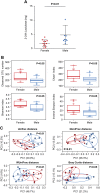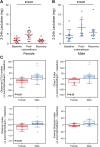Sex differences in NSAID-induced perturbation of human intestinal barrier function and microbiota
- PMID: 29897814
- PMCID: PMC6219825
- DOI: 10.1096/fj.201800560R
Sex differences in NSAID-induced perturbation of human intestinal barrier function and microbiota
Abstract
Intestinal barrier function and microbiota are integrally related and play critical roles in maintenance of host physiology. Sex is a key biologic variable for several disorders. Our aim was to determine sex-based differences in response to perturbation and subsequent recovery of intestinal barrier function and microbiota in healthy humans. Twenty-three volunteers underwent duodenal biopsies, mucosal impedance, and in vivo permeability measurement. Permeability testing was repeated after administration of indomethacin, then 4 to 6 wk after its discontinuation. Duodenal and fecal microbiota composition was determined using 16S rRNA amplicon sequencing. Healthy women had lower intestinal permeability and higher duodenal and fecal microbial diversity than healthy men. Intestinal permeability increases after indomethacin administration in both sexes. However, only women demonstrated decreased fecal microbial diversity, including an increase in Prevotella abundance, after indomethacin administration. Duodenal microbiota composition did not show sex-specific changes. The increase in permeability and microbiota changes normalized after discontinuation of indomethacin. In summary, women have lower intestinal permeability and higher microbial diversity. Intestinal permeability is sensitive to perturbation but recovers to baseline. Gut microbiota in women is sensitive to perturbation but appears to be more stable in men. Sex-based differences in intestinal barrier function and microbiome should be considered in future studies.-Edogawa, S., Peters, S. A., Jenkins, G. D., Gurunathan, S. V., Sundt, W. J., Johnson, S., Lennon, R. J., Dyer, R. B., Camilleri, M., Kashyap, P. C., Farrugia, G., Chen, J., Singh, R. J., Grover, M. Sex differences in NSAID-induced perturbation of human intestinal barrier function and microbiota.
Keywords: gender; indomethacin; lactulose; microbiome; permeability.
Conflict of interest statement
The authors thank L. Anderson (Mayo Clinic) for administrative assistance. This project was funded by grants from the Mayo Clinic Department of Laboratory Medicine and Pathology, Mayo Clinic Division of Gastroenterology and Hepatology, and by the U.S. National Institutes of Health, National Institute of Diabetes and Digestive and Kidney Diseases (NIDDK) Grant K23 DK103911 (to M.G.). J.C. is supported by Mayo Clinic Center for Individualized Medicine. M.G. has served on the advisory board or received research support from Takeda, DongA, Ironwood, and Napo. The remaining authors declare no conflicts of interest.
Figures






References
-
- Peters S. A., Edogawa S., Sundt W. J., Dyer R. B., Dalenberg D. A., Mazzone A., Singh R. J., Moses N., Smyrk T. C., Weber C., Linden D. R., MacNaughton W. K., Turner J. R., Camilleri M., Katzka D. A., Farrugia G., Grover M. (2017) Constipation-predominant irritable bowel syndrome females have normal colonic barrier and secretory function. Am. J. Gastroenterol. 112, 913–923 - PMC - PubMed
-
- Bjarnason I., MacPherson A., Hollander D. (1995) Intestinal permeability: an overview. Gastroenterology 108, 1566–1581 - PubMed
-
- Hernández-Díaz S., Rodríguez L. A. (2000) Association between nonsteroidal anti-inflammatory drugs and upper gastrointestinal tract bleeding/perforation: an overview of epidemiologic studies published in the 1990s. Arch. Intern. Med. 160, 2093–2099 - PubMed
Grants and funding
LinkOut - more resources
Full Text Sources
Other Literature Sources

